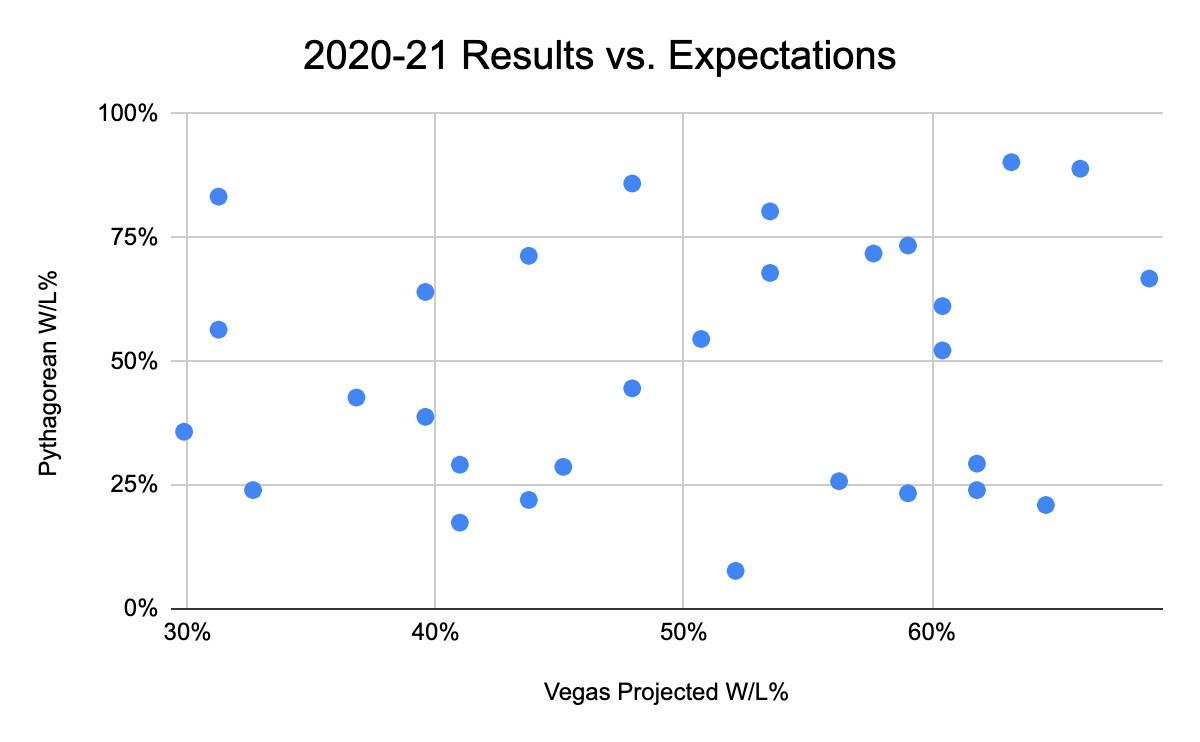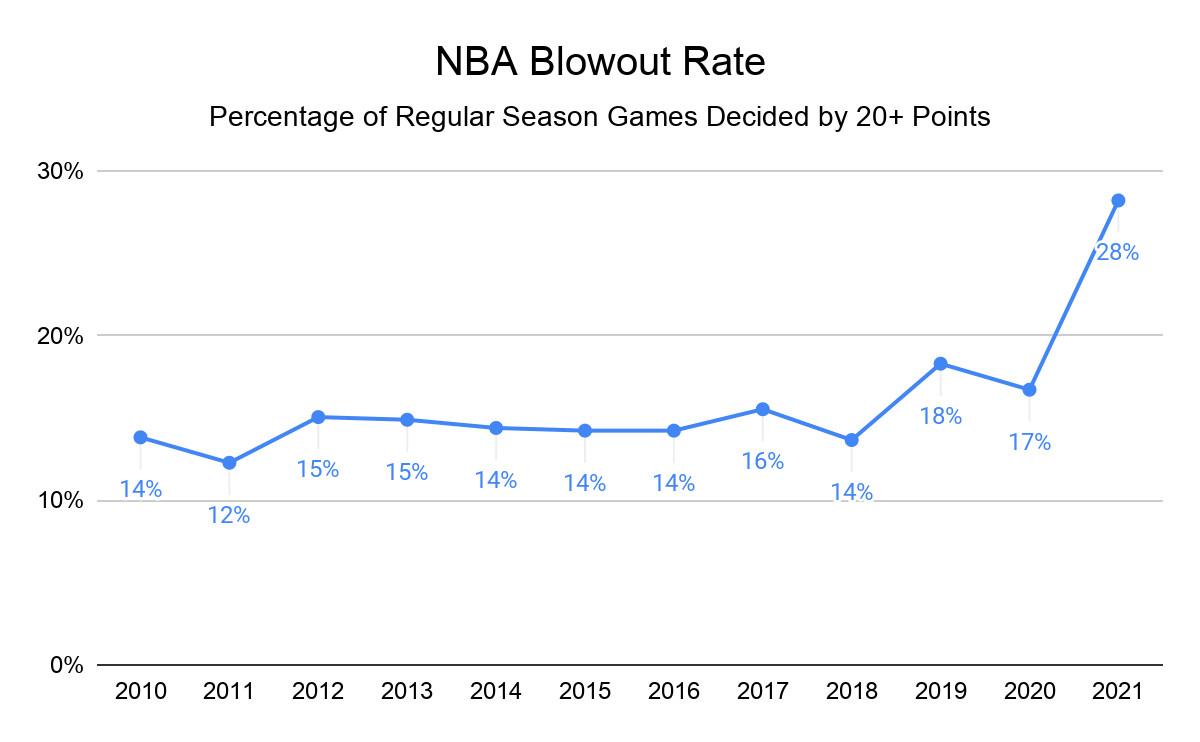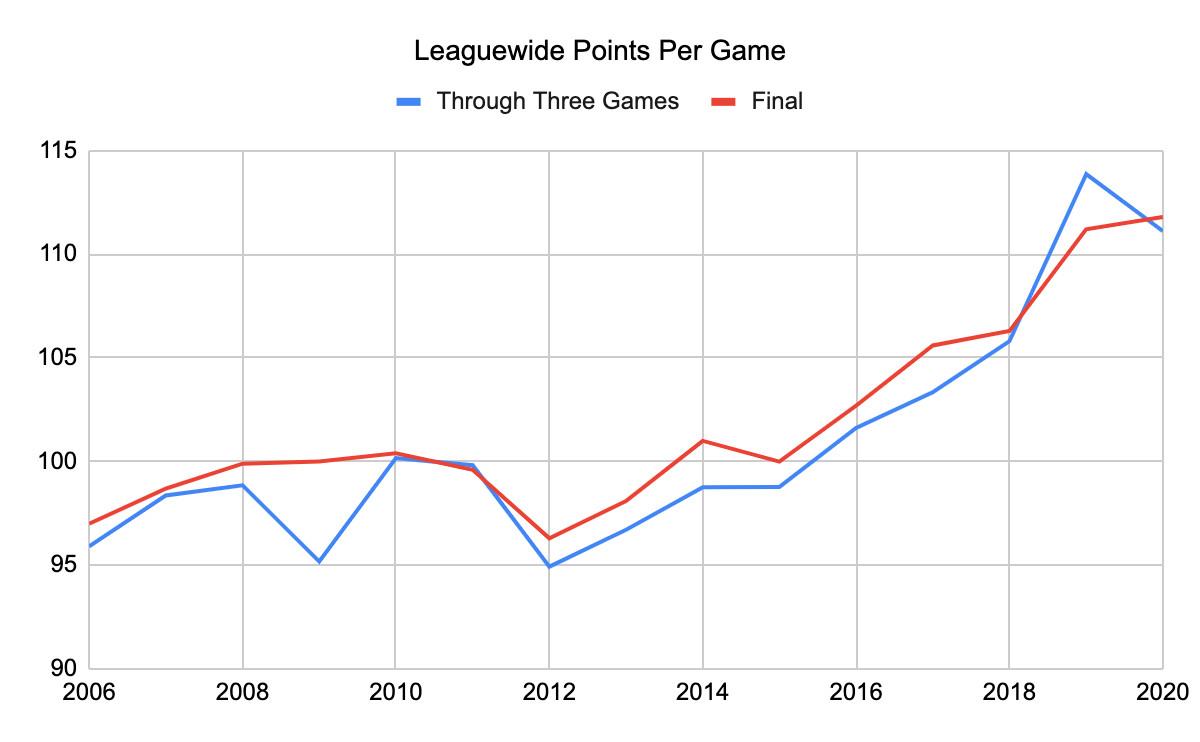The first week of the 2020-21 NBA season pushed all the expected results through a blender. The Knicks blew out the Bucks on the same night that the undefeated Cavaliers blew out the 76ers. The Thunder were the West’s last unbeaten team. The Mavericks pounded the Clippers by a record-setting 50 points in one half.
We might forget all about these results in a few weeks. Just last season, the Bucks started 2-2—and then pushed their record to 24-3 en route to one of the best regular seasons (pre-bubble) in NBA history. But in the meantime, let’s take a jaunt through some early trends and think about what’s real versus what oddities are more likely mirages.
Upside-Down Standings
Through Sunday’s games, only six teams in the East had a winning record: the 3-0 Pacers, the 2-1 76ers, and four teams that finished with a losing record last season. The Bucks, Raptors, and Celtics—last season’s top three seeds—are a combined 2-6.
The Western picture isn’t much more logical. Record-setting blowout loss by the Clippers aside, both L.A. teams are in good shape in the standings, but out of the six teams that missed the playoffs or play-in round last season, five have winning records. The only exception is Golden State.
Just how bizarre have the early goings been? We can compare the standings to Vegas’s over/under preseason figures, which are normally reliable barometers for each team. Across the past 15 seasons, the correlation between teams’ Vegas-projected winning percentage and actual winning percentage is 0.76, on a scale in which 0 means no relationship and 1 a perfect relationship. That’s pretty good—and consistently so, as the correlation has been 0.66 or better every season in that span. (All preseason over/unders in this piece are from Sports Odds History and Basketball-Reference’s archives.)
So far this season, however, the correlation is negative-0.07. Yes, negative—meaning that if you had wanted to predict the standings through the first week, you’d have been better off going by the opposite of the preseason predictions.
Pythagorean record, based on point differential, is a bit more in line with expectations, with a 0.16 correlation with projections so far. But it’s still atypically low. We’d expect the data points on this graph, each of which represents a team’s performance thus far, to form almost a straight line; instead, the dots appear jumbled at random.

This reversal of expectations won’t continue, of course. Even in a season with unprecedented travel plans and absences due to COVID-19, it would be a massive surprise if the end-of-season figure wasn’t up in the 0.7 range like normal. But in the past 15 seasons, the correlation between preseason predicted winning percentage and actual winning percentage through three games has still been a solid 0.38. The NBA is such a skill-driven league that it usually provides reliable results even in small samples. Not this season.
Pleasant Surprises
One reason for the strange standings is the early schedule disparity. As The Athletic’s Seth Partnow noted, only three of the undefeated teams’ total wins have come against 2020 playoff teams (Magic over Heat, Cavaliers over 76ers, and Pacers over Celtics).
But a surprise has to start somewhere, and for a team like the Cavaliers, expected to compete for the no. 1 draft pick, a 3-0 start is nothing to scoff at. LeBron James started 3-0 just once in Cleveland. (Nobody tell the Cavaliers that the 2019-20 Timberwolves, who actually did end up with the no. 1 pick, also started 3-0.)
This chart shows the teams since 2005-06 that have overperformed their Vegas over/under by the widest margin.
Biggest NBA Overachievers, 2006-2020
It would be nice, analytically, if there were one common trait for all of these teams. Then I could point and say, “This is how to overachieve.” That’s not the case, though; this is a varied group of squads, with some title winners and some no. 1 seeds and some forgettable teams that were merely mediocre rather than abjectly terrible.
One general commonality for a bunch of them, however, is the emergence of a foundational franchise player in the season in question. The 2009 Cavaliers, 2011 Bulls, and 2015 Warriors all had a first-time MVP, in LeBron, Derrick Rose, and Steph Curry, respectively. Victor Oladipo made his first All-Star team for the 2018 Pacers; ditto Kevin Durant with the 2010 Thunder, for whom he also led the league in scoring. For the 2014 Trail Blazers, Damian Lillard made his first All-Star team; for the 2016 Trail Blazers, CJ McCollum jumped from 6.8 points per game to 20.8, helping to replace the departed LaMarcus Aldridge. The Hornets made two jumps with Chris Paul, who joined the team for the 2006 season and made his first All-Star team in 2008. Giannis Antetokounmpo found his first season of meaningful playing time with the 2015 Bucks.
This conclusion is somewhat tautological—a team overachieves when its best player overachieves—but it’s a useful guide when thinking about whether current teams can make a similarly sized leap.
If the Cavaliers are a real contender for a back-end Eastern playoff spot, for instance, that surprise would start with Collin Sexton, who’s averaging 27 points per game with a 65 percent effective field goal percentage thus far. That kind of efficiency won’t last through a full season, and the third-year guard still has a lot to prove on the defensive end—but dating back to the middle of last season, Sexton has scored at a prolific pace.
A Tale of Two Collin Sextons
Or if the Hawks are for real, Trae Young’s ascent to All-NBA level would be an obvious reason. Markelle Fultz is also averaging 20.7 points per game for the Magic. It’s early yet, but returns are encouraging for a group of potential breakout guards.
Bevy of Blowouts
It’s not just Dallas’s shellacking of the Clippers—though that box score is a sight to behold. The first week of this season has been chock full of blowouts, with 11 of the first 39 games this season decided by 20-plus points. That’s 28 percent of all games, about double the blowout rate in the last decade.

As the past two seasons demonstrate, blowout frequency was already on the rise because of the leaguewide scoring increase. It’s easier to win a game 120-100 than 100-80. (In the former, the victor needs to outscore the loser by 20 percent; in the latter, 25 percent.) But this season’s early rate goes well beyond that trend.
Looking just at blowouts within a team’s first three games, the 2020-21 campaign is one shy of the NBA record of 12, set in 1989-90. The average number of 20-plus-point blowouts in teams’ first three games is about five per year, meaning we’re at double the usual pace so far. And there’s still room for this season’s number to rise, as the Heat, Raptors, Thunder, and Rockets all still have their third games to play.
Plenty of Points
Given the league’s direction in the past few seasons, it’s no surprise that offense is up yet again. Through Sunday’s games, teams were averaging 112.9 points per game, which is up more than a point from last season and would make this the highest-scoring season since 1969-70.
How should we expect this number to change as the season continues? Even in a very small sample, there’s a lot of signal in this data. In the past 15 seasons, the league’s final scoring average has been one point per game higher than the average through three team games, and in 13 of those 15 years, scoring rose by at least a bit.

Two countervailing trends balance to produce this stability. On the one hand, leaguewide pace is typically higher early in the season, with teams slowing down a touch during a long campaign. (Could that pattern be sharper than usual this season, with the condensed schedule? Maybe, but it wasn’t during the shortened 2011-12 season.) On the other, leaguewide scoring efficiency is typically lower early in the season, with players essentially shooting their way into shape over time.
This historical analysis doesn’t mean every high-scoring team this season will continue at their current rates. Six teams are averaging 120-plus points per game—a threshold nobody has reached over a full season since the 1984-85 Nuggets. But we might not be far off this year, and we’ve already seen individual games with scores of 130-120, 129-128, and 128-126. That kind of scoreboard-buster might be a nightly occurrence all season long.
